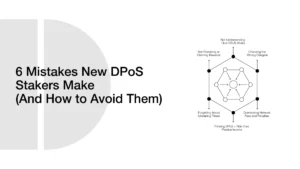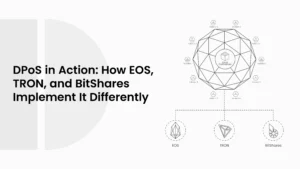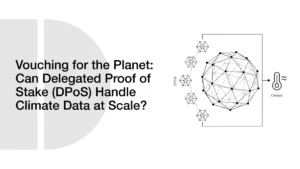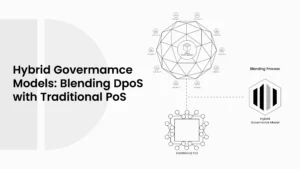Breaking Down DPoS Architecture: From Block Creation to Governance Cycles
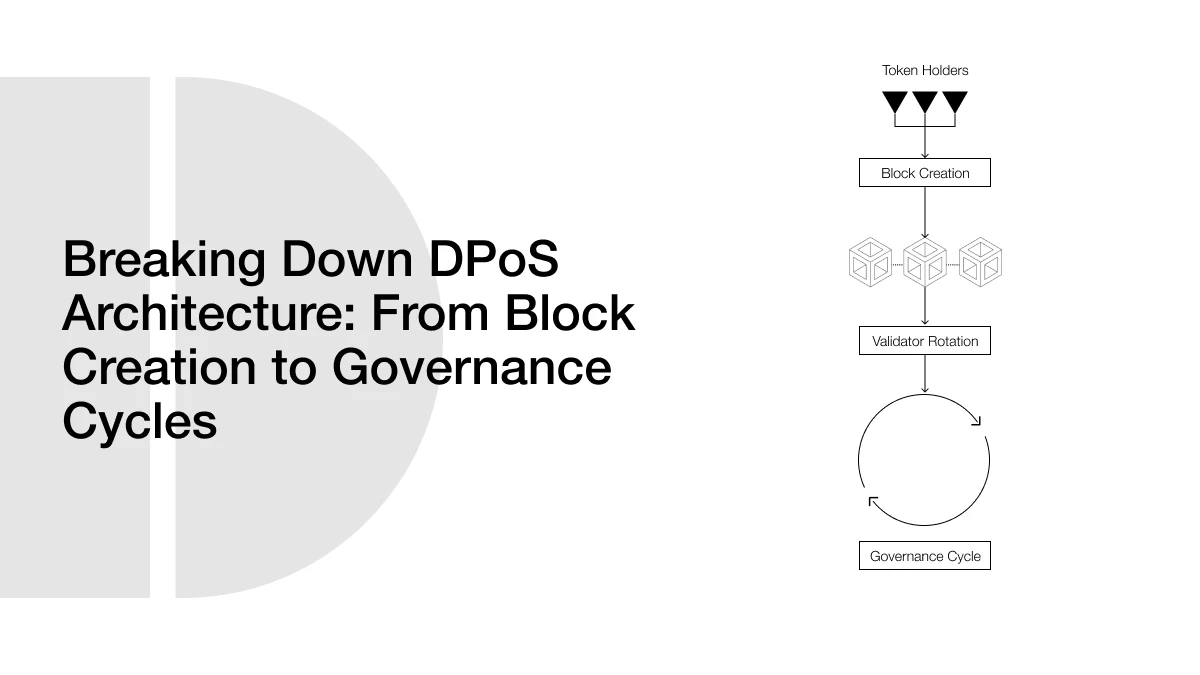
Delegated Proof of Stake (DPoS) is known for being one of the most performance-optimized and governance-friendly blockchain consensus models. But what makes it so efficient under the hood? The answer lies in its unique architecture built around blocks, rounds, and epochs: three fundamental components that work in harmony to produce a fast, fair, and community-driven blockchain.
- What Are Blocks in DPoS? (And How They’re Created)
- How Validators Take Turns to Produce Blocks
- Why Epochs Matter in DPoS Governance
- How DPoS Ensures Fast Finality and Ledger Sync
- Top 5 DPoS Blockchains to Watch in 2025
- Why DPoS Is Ideal for Scalable Blockchain Systems
- Frequently Asked Questions (FAQs)
- Glossary of Key Terms
In a conventional Proof of Work (PoW) model, such as Bitcoin, blocks are created by competing miners, which can result in delays and increased energy expenses. With DPoS, however, block creation is orderly and predictable. The token holders elect a small number of trusted validators, known as block producers, to produce blocks in turn, according to a predetermined schedule. This architecture eliminates randomness and waste, ensuring short confirmation times.
As the need to have faster, scalable, and more democratic systems is increasing, it is necessary to take a closer look at the DPoS architecture, not only by developers but also by any person interested in the workings of the modern blockchain platforms. This blog will look at each of the layers in detail and how DPoS balances what many consensus models are yet to balance.
What Are Blocks in DPoS? (And How They’re Created)
In a Delegated Proof of Stake (DPoS) protocol, the blocks are the basic information units that contain verified transactions. Each time a user broadcasts tokens, deploys a smart contract, or communicates with the network, such activity is packaged into a block. It is a straightforward yet elegant process: block producers alternate and validate, generating blocks according to a rigid schedule.
ALSO READ: How to Integrate Smart Contracts with DPoS-Based Blockchains
In contrast to Proof of Work, where the block creation system is based on difficult puzzles, DPoS enables block producers, who are pre-selected through a delegate voting system, to create and sign blocks at a high rate. This significantly minimizes the amount of energy used and increases the speed of transactions. Indeed, DPoS chains, such as EOS and Solar Network, have the fastest block generation time (0.5 to 3 seconds), which is one of the fastest in the blockchain industry.
Every block is assigned a unique identifier and contains the hash of the previous block, creating an unchangeable chain of records. In the majority of DPoS systems, failure by a block producer to produce a block at their turn or produce a faulty block can result in punishment or the loss of votes. Such a mechanism of accountability is one of the reasons why DPoS is one of the most effective consensus models used today.
The rapidity and regularity of block generation are key to achieving fast finality, which ensures that a transaction cannot be rolled back. DPoS can be finalized on a few blocks, making it ideal for use in real-time demands, such as payments, games, and DeFi systems.
How Validators Take Turns to Produce Blocks
Rounds are another key component of the DPoS (Delegated Proof of Stake) architecture. A round is a cycle where each elected block producer gets a turn to create a block. The length of a round depends on how many block producers the system allows; for example, if there are 21 producers, a round consists of 21 blocks. The purpose of rounds is to ensure fairness and order. Every active producer knows when they’re scheduled to validate a block. This prevents block races (common in Proof-of-Work systems) and reduces latency across the network. It also allows the network to instantly identify if a producer fails to deliver on their duties.
What’s particularly unique about DPoS rounds is how voting incentives and rotation mechanics keep the system dynamic. After a round is completed, the network reevaluates which producers have the most votes. Poor-performing producers can be replaced by new candidates, maintaining competitiveness and decentralization. This structure ties into game theory principles: producers must act honestly or risk being voted out in the next cycle (Hackernoon, 2022).
Additionally, because the system relies on scheduled participation rather than probabilistic block mining, it becomes easier to monitor, audit, and optimize. This structure offers not only improved governance but also enhanced throughput for both enterprise and public blockchain platforms.
ALSO READ: Is Delegated Proof of Stake (DPoS) the Most Scalable Consensus Mechanism Ever?
Why Epochs Matter in DPoS Governance
| Feature | Description | Purpose in DPoS |
| Epoch Definition | A fixed time interval comprising multiple validator rounds | Groups rounds into manageable governance periods |
| Voting Reset | Token holders can recast votes at the end of an epoch | Keeps the validator set dynamic and prevents centralization |
| Reward Adjustment | Reward rates and distribution schedules may reset or update | Encourages fairness and adapts to network changes |
| Protocol Updates | Used as natural checkpoints to deploy protocol or consensus changes | Smooth implementation of network upgrades |
| Validator Evaluation | Producer performance is reviewed at epoch end | Ensures accountability and enables rotation based on community trust |
| Token Economics | Epochs may trigger inflation schedules or staking terms | Manages long-term supply, staking lockups, or burn mechanics |
| Governance Proposals | Voting periods for protocol changes often align with epoch cycles | Helps coordinate stakeholder decisions and system-wide proposals |
| Comparative Example | Like Ethereum’s “slot finality” checkpoints | Maintains stability and decision cadence in fast-moving DPoS chains |
Epochs are broader time frames that contain multiple rounds. While rounds are designed to facilitate the fair rotation of producers, epochs are often used for network governance, token distribution adjustments, and performance analysis. In essence, epochs act like checkpoints in the DPoS lifecycle. In many DPoS-based networks, voting weights and reward schemes are reset or adjusted at the end of each epoch. This design enables communities to make strategic decisions over time, such as changing reward rates, updating protocol parameters, or integrating smart contract upgrades. Epochs bring rhythm and structure to the governance process, keeping the chain responsive to stakeholder input.
For instance, at the end of each epoch, token holders might recast their votes to elect new block producers or reaffirm their support for existing ones. This cyclical governance helps prevent centralization and keeps producer performance in check. It also enhances the transparency and adaptability of the network, especially in delegated environments where voter behavior shapes consensus.
Moreover, epochs can be tied to smart contract logic or external events. For example, DPoS platforms may use epochs to schedule inflationary rewards or adjust staking terms, contributing to the broader economics and sustainability of the network. The concept of epochs is similar to Ethereum’s slot-finalized checkpointing mechanism in Proof of Stake, though DPoS architectures often use shorter and more flexible epochs for real-time responsiveness (Medium, 2023).
How DPoS Ensures Fast Finality and Ledger Sync
| Metric | DPoS | PoW |
| Execution Speed | Fast (1–3 seconds per block) | Slow (10+ minutes per block in Bitcoin) |
| Gas/Fees | Low to Moderate | High, especially on congested networks |
| Scalability | High – Parallel execution possible | Low – Sequential mining bottlenecks |
| Throughput (TPS) | 1,000+ TPS (e.g., EOS, TRON) | 7–15 TPS (e.g., Bitcoin, Ethereum PoW) |
| Energy Efficiency | Very high – no mining required | Very low–intensive hardware usage |
| Finality | Fast (a few seconds to 1 min) | Slow (6+ confirmations; ~60 minutes) |
| Smart Contract Support | Native in platforms like EOS, TRON, WAX | Limited (BTC), or resource-heavy (ETH PoW) |
| Developer Ecosystem | Active with tooling for fast deployment | Mature but slower evolution in PoW chains |
Synchronization in any blockchain refers to the extent to which nodes can agree on the current state of the ledger. Delegated Proof of Stake (DPoS) features a predictable and orderly production cycle, which enhances synchronization. Since every block producer has a transparent and timed turn, nodes will be able to stay in synchronization more easily than in Proof of Work blockchains, where the time to make a block is random and prone to network latencies.
It is the obvious sequence of blocks, rounds, and epochs that allows us to guarantee that every part of the system knows when the next block will be produced and by whom. Such transparency enables nodes to be prepared to accept data, verify it in seconds, and reach a consensus in milliseconds rather than minutes. It also makes DPoS systems more usable in real-time data processing applications, such as digital asset trading, supply chain verification, and IoT.
ALSO READ: How DPoS Turns Token Holders Into Decision Makers | Crypto Democracy in Action
DPoS finality is typically achieved within a significantly shorter timeframe than conventional consensus systems. Blocks can be completed in one to two confirmations because a small, elected group of producers is allowed to create blocks, and their actions are always monitored by voters. For example, on EOSIO-based systems, finality can be achieved in just a few seconds, providing almost immediate confidence that a transaction is permanent.
Top 5 DPoS Blockchains to Watch in 2025
| Blockchain | Primary Use Case | Notable Feature |
| EOS | General-purpose | High TPS, enterprise-grade apps |
| TRON | Entertainment | Popular for streaming and dApps |
| WAX | Gaming | NFT marketplace + ultra-low fees |
| Lisk | JavaScript SDK | Dev-friendly with modular SDK |
| Ark | Bridge Chains | Focus on interoperability + plugins |
Why DPoS Is Ideal for Scalable Blockchain Systems
DPoS architecture has an unusual combination of speed, organization, and stakeholder control based on blocks, rounds, and epochs. Every component is essential: blocks regulate the flow of transactions, rounds promote fairness of producers, and epochs determine the long-term cycle of governance and economics.
Being aware of the interaction between these factors, developers, researchers, and blockchain enthusiasts will be better equipped to understand why DPoS is the paradigm they should use when creating high-performance, community-driven platforms. The planned block generation, rapid finality, and other aspects of DPoS demonstrate how blockchain may evolve to accommodate the increasing demand for efficient, scalable, and secure digital systems.
With further innovation and as additional networks experiment with hybrid or enhanced forms of DPoS, the tenets of this architecture will still be central to the third generation of decentralized infrastructure.
Frequently Asked Questions (FAQs)
- What is DPoS, and how does it differ from PoS?
DPoS (Delegated Proof of Stake) enables token holders to vote for a select group of trusted validators. Unlike PoS, where anyone with enough stake can become a validator, DPoS systems focus on elected block producers.
- What are blocks, rounds, and epochs in DPoS?
Blocks contain transaction data. Rounds are cycles where each validator produces a block. Epochs are larger intervals used for governance updates and voting resets.
- How does DPoS achieve faster transaction speeds than PoW?
In DPoS, validators are pre-scheduled and don’t compete through mining. This results in quicker block times and lower energy use compared to Proof of Work systems.
- Can validators be changed in DPoS?
Yes, block producers can be replaced during the voting process. If a validator underperforms, they may lose votes and be removed from the rotation.
- Which blockchains use DPoS?
Examples include EOS, TRON, WAX, Lisk, and Ark, each using DPoS for scalability, efficiency, and community governance.
Glossary of Key Terms
- DPoS (Delegated Proof of Stake): A consensus algorithm where token holders vote for a set number of block producers to validate transactions.
- Block Producer / Validator: A node elected to generate and confirm blocks.
- Round: A cycle where each validator gets a turn to produce a block.
- Epoch: A longer period containing several rounds, often used for governance or reward recalculations.
- Finality: The point at which a block is confirmed and cannot be altered.
- Slashing: A penalty mechanism for misbehaving validators.
- Smart Contract Throughput: A measure of how many smart contract transactions a blockchain can process per second.

